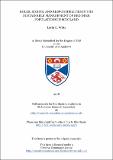Files in this item
Roles, rights, and responsibilities in the sustainable management of red deer populations in Scotland
Item metadata
| dc.contributor.advisor | Brown, Verity Joy | |
| dc.contributor.author | Witta, Lorin E. | |
| dc.coverage.spatial | ix, 130, xiii p. | en_US |
| dc.date.accessioned | 2018-06-26T08:17:55Z | |
| dc.date.available | 2018-06-26T08:17:55Z | |
| dc.date.issued | 2018-06-29 | |
| dc.identifier.uri | https://hdl.handle.net/10023/14571 | |
| dc.description.abstract | The aim of the project was to explore the acquisition and dissemination of knowledge amongst decision-makers involved in the management of red deer in Scotland. While research exists on the ecology of red deer habitat, no research exists that focuses on the relationship between the deer and the people responsible for their management. Therefore, this thesis is primarily qualitative research which aimed to explore the various aspects of red deer management in Scotland within the socio-ecological context in which it exists. There are numerous groups with interest in red deer management, however this research, due to scope and time restrictions, was limited to two primary groups, the individuals tasked with implementing policy and the practitioners who carry out culling. During the course of the project, under-researched topics surfaced, highlighting areas of practical and theoretical divergence between stakeholders. This thesis therefore aims to explore how differing views and perspectives of two of the key stakeholder groups – the estate-based practitioners (including stalkers, land-managers, and land-owners) and staff of governmental agencies – influence the management of red deer in Scotland. This research indicates that people with different roles hold different relationships with the deer, which affect management decisions and implementation at local, regional, and/or national level. As with other areas within conservation and wildlife management, this research indicates there is a disconnect between blanket governmental policy and site-specific needs, with a lack of inclusion of practitioner knowledge. Potential future research would include additional qualitative research to follow up some of the management issues raised by this research and formulate recommendations for changes to practice, followed by collection of quantitative data assessing the efficacy of interventions. | en_US |
| dc.language.iso | en | en_US |
| dc.publisher | University of St Andrews | |
| dc.rights | Attribution-NonCommercial-NoDerivatives 4.0 International | * |
| dc.rights.uri | http://creativecommons.org/licenses/by-nc-nd/4.0/ | * |
| dc.subject | Red deer | en_US |
| dc.subject | Environmental management | en_US |
| dc.subject | Wildlife management | en_US |
| dc.subject | Wildlife conflicts | en_US |
| dc.subject | Conservation | en_US |
| dc.subject | Red deer management | |
| dc.subject | Decision making | en_US |
| dc.subject | Socio-ecological context | en_US |
| dc.subject | Scotland | en_US |
| dc.subject | Sustainable management | en_US |
| dc.subject | Human-animal relationships | en_US |
| dc.subject | Qualitative | en_US |
| dc.subject | Management perspectives | en_US |
| dc.subject | Practitioner knowledge | en_US |
| dc.subject | Policy vs. practice | en_US |
| dc.subject.lcc | QL737.U55W58 | |
| dc.subject.lcsh | Red deer--Scotland--Management | en |
| dc.subject.lcsh | Red deer--Effect of human beings on--Scotland | en |
| dc.title | Roles, rights, and responsibilities in the sustainable management of red deer populations in Scotland | en |
| dc.type | Thesis | en_US |
| dc.type.qualificationlevel | Doctoral | en_US |
| dc.type.qualificationname | PhD Doctor of Philosophy | en_US |
| dc.publisher.institution | The University of St Andrews | en_US |
The following licence files are associated with this item:
This item appears in the following Collection(s)
Except where otherwise noted within the work, this item's licence for re-use is described as Attribution-NonCommercial-NoDerivatives 4.0 International
Items in the St Andrews Research Repository are protected by copyright, with all rights reserved, unless otherwise indicated.


